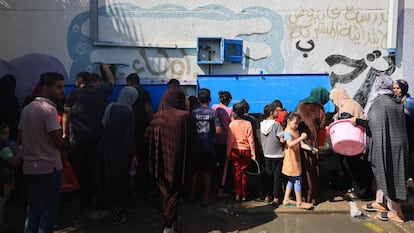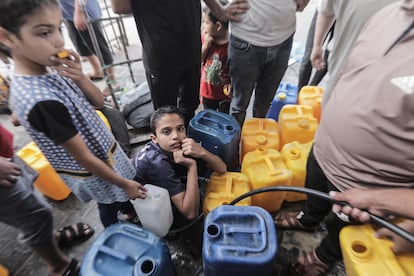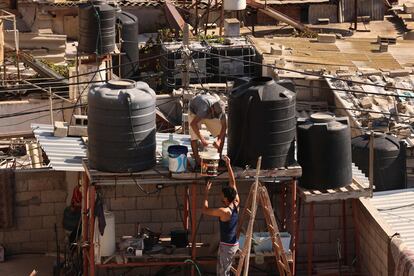Gaza is dying of thirst
Palestinians on the Strip have only three liters of water a day, because Israel is blocking the supplies and energy needed to keep supply and distribution facilities running


Water is about to run out in Gaza. The total blockade imposed by Israel after the Oct. 7 Hamas attack has interrupted the arrival of drinking water distributed in Gaza through a pipeline from Israeli territory. Israel is also blocking any electricity and fuel from reaching the Strip, which makes it impossible for the three desalination plants in Gaza to operate. In addition to the interruption of supplies, the Israeli bombardments “have hit numerous installations, both for water supply, storage, and sewage” and prevent the circulation of tanker trucks that still have fuel to circulate, says Pilar Orduña, head of humanitarian action at Oxfam Intermón. The result is that there are hardly any resources left in a region that was already suffering from severe water shortages and sanitation deficits, Orduña denounces.
“My mission tomorrow is basically to get water,” laments Sami, a Palestinian UNICEF staff member in Gaza, in an audio distributed by the UN fund. The man, who has had to leave his home in the north of the Strip with his wife and five children, is sheltering from air strikes by the Israeli armed forces in a 70-square-meter space where 17 people live together. “Children and adults, all together and no running water… Today I had to go and collect water in buckets, water that is basically for bathing, because we can’t use it for anything else. We have been drinking from the bottles we had, but we are already running out,” he adds. Rania (not her real name), an Amnesty International aid worker who is a refugee in Rafah, also says in statements distributed by this organization that she is struggling to “find water.” “It is very difficult to find and very expensive,” she explains.
Prior to the current conflict, Palestinians were already facing severe water shortages and had a very poor water supply system. According to a 2022 World Health Organization (WHO) multi-sectoral needs analysis, 82% of Gazans received water through private water trucking; 13% were supplied by public taps; only 4% had piped water at home and 1% needed to consume bottled water. The three desalination plants, which are no longer operational, produced 21 million liters of drinking water per day, according to UNRWA, the UN agency for Palestinian refugees.

But now, “drinking water has practically run out,” Oxfam denounces. And the agreement reached between Israel and the United States to allow the entry of food, water, or medicines from Egypt will be “insufficient” to cover the consumption needs of the population, the organizations agree. According to calculations by the UN Water and Energy Cluster, there are now only “three liters of water per day available per person in Gaza.” “A five-minute shower uses up about 100 liters of water,” Orduña notes.
In this situation of scarcity, the owners of water purification plants, most of which run on solar energy, “are the biggest suppliers,” he continues. But the “price has quintupled,” according to Oxfam aid workers in Gaza.
The main priority
The difficulty of acquiring water has pushed many people, according to the various NGOs consulted, to draw water from agricultural wells, provided they have enough fuel or energy to activate the pumps. However, 81% of the water extracted from Gaza’s aquifer does not meet the minimum quality standards required by the WHO. The Palestinian Central Bureau of Statistics puts this percentage at 97%. UNICEF has denounced that some people have been forced to drink seawater.
Therefore, despite the shortage of all basic necessities, the most pressing task in the Palestinian enclave is to find water. “We have reached a point where it is our top priority,” explains Guillemette Thomas, coordinator of Doctors Without Borders in Palestine — an assertion shared by all the organizations consulted. “It is estimated that 60% of Gaza’s inhabitants, more than one million people, live in the open, without access to water or health care.”

The problem does not only affect consumption. “Gaza’s five sewage treatment plants have been forced to close,” Orduña explains. The consequence is that “untreated sewage is being discharged into the sea” and that some streets are beginning to “accumulate solid waste,” increasing the risk of outbreaks of life-threatening infectious diseases such as cholera or diarrhea, which can be particularly serious for young children. Thomas elaborates: “In addition to the seriously injured, we risk witnessing a wave of diseases related to poor living conditions,” such as diarrhea, respiratory and skin infections, and dehydration.
Sign up for our weekly newsletter to get more English-language news coverage from EL PAÍS USA Edition
Tu suscripción se está usando en otro dispositivo
¿Quieres añadir otro usuario a tu suscripción?
Si continúas leyendo en este dispositivo, no se podrá leer en el otro.
FlechaTu suscripción se está usando en otro dispositivo y solo puedes acceder a EL PAÍS desde un dispositivo a la vez.
Si quieres compartir tu cuenta, cambia tu suscripción a la modalidad Premium, así podrás añadir otro usuario. Cada uno accederá con su propia cuenta de email, lo que os permitirá personalizar vuestra experiencia en EL PAÍS.
¿Tienes una suscripción de empresa? Accede aquí para contratar más cuentas.
En el caso de no saber quién está usando tu cuenta, te recomendamos cambiar tu contraseña aquí.
Si decides continuar compartiendo tu cuenta, este mensaje se mostrará en tu dispositivo y en el de la otra persona que está usando tu cuenta de forma indefinida, afectando a tu experiencia de lectura. Puedes consultar aquí los términos y condiciones de la suscripción digital.
More information
Archived In
Últimas noticias
Welcome to the post-religion era: The idea of Christianity as the absolute truth has become obsolete
‘I thought you would like it’: The risky sexual practice popularized by TV shows and TikTok
The digitalization of tourism: ‘They promise experiences and gave us the worst possible one’
Mexican peso defies uncertainty with forecasts of a new period of stability in 2026
Most viewed
- Sinaloa Cartel war is taking its toll on Los Chapitos
- Reinhard Genzel, Nobel laureate in physics: ‘One-minute videos will never give you the truth’
- Oona Chaplin: ‘I told James Cameron that I was living in a treehouse and starting a permaculture project with a friend’
- Why the price of coffee has skyrocketed: from Brazilian plantations to specialty coffee houses
- Silver prices are going crazy: This is what’s fueling the rally









































